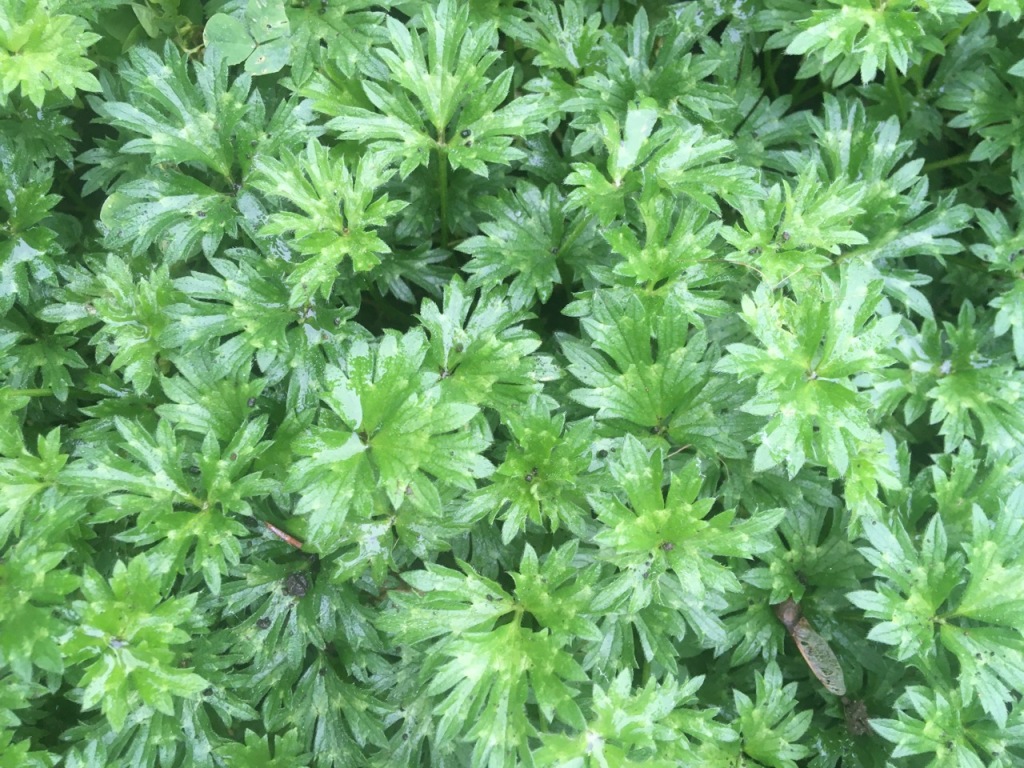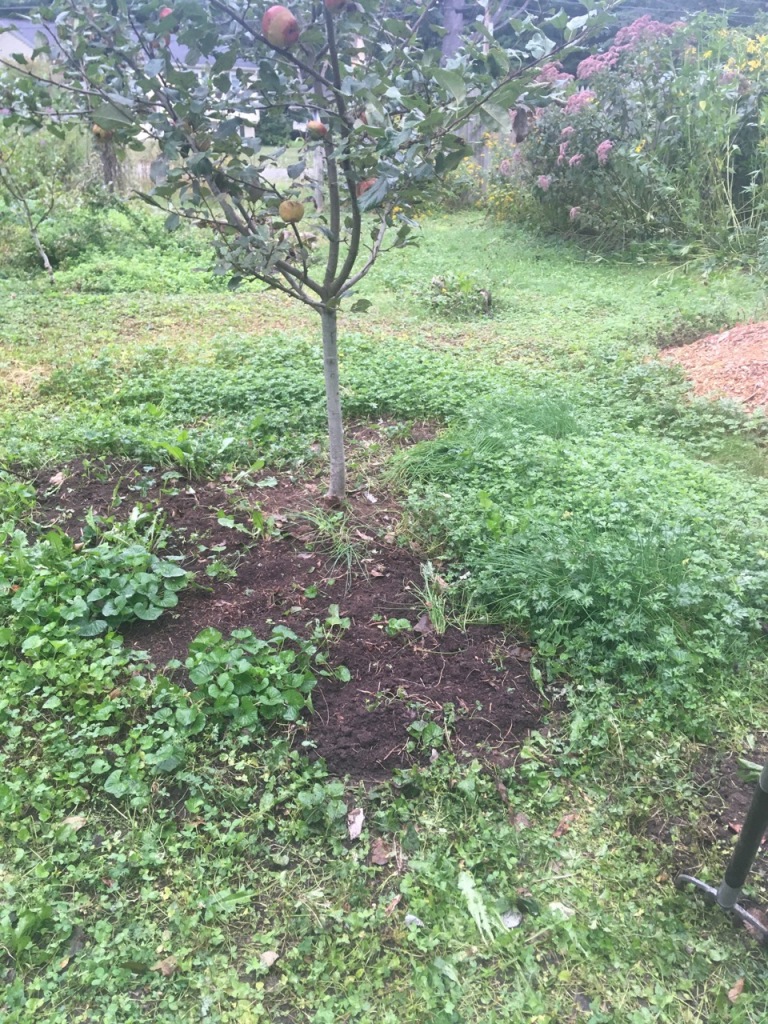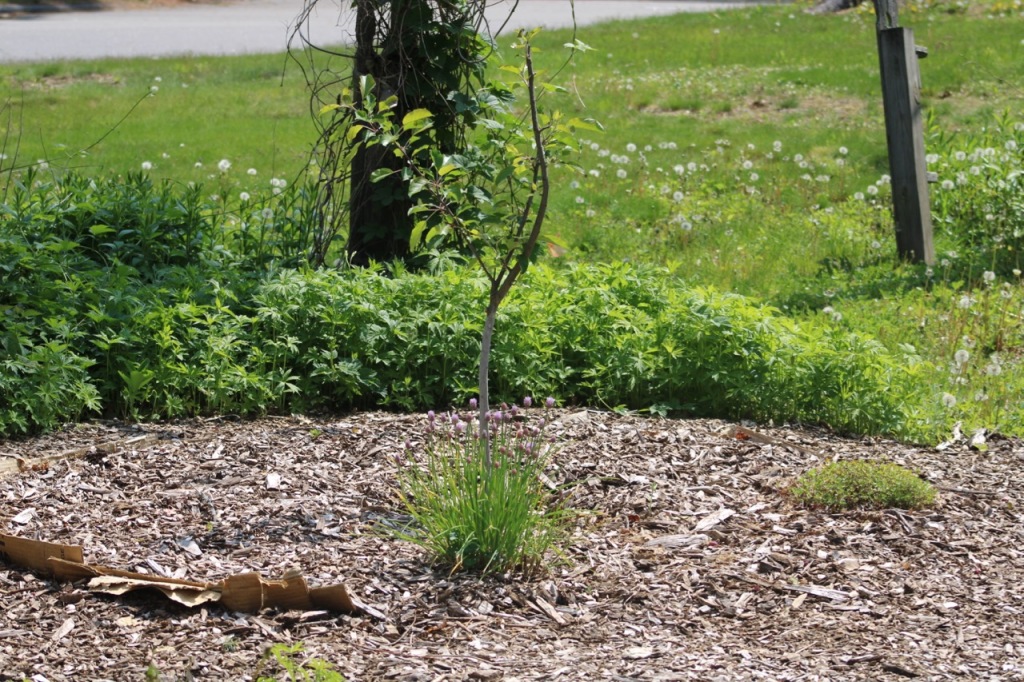Earlier this summer, I discovered a few lovely yellow buttercup flowers under the Honeycrisp apple tree. I didn’t think too much about it. They were so pretty. Later, when I was mowing the orchard undergrowth, I mowed those flowers along with everything else. But more recently, I realized that the buttercups had spread all over the ground near that tree, and were crowding out any other plants. So once again, I did some research and discovered that Ranunculus repens, creeping buttercup, is considered invasive in Maine.
I don’t know how it got here. And it is likely that I won’t be able to get rid of it entirely–each plant puts out horizontal stems that take root at its nodes and form new plants at each node. But I have to try. Further research suggested that using a garden fork to loosen the soil and lift up the plants was a good way to pull the plants with their roots. Also, it prefers acidic soil, so adding lime to make the soil less acidic can discourage them. I started pulling them yesterday, and did some more this morning before the rain came.
I was complaining about all this to Margy, and she reminded me that a large part of our gardening is removing problematic plants in order to encourage beneficial plants. So while I delight in the violets that spread everywhere, and the wild strawberries–both native ground covers that have flourished in the orchard, I also have to reckon with these invaders that come in from who knows where.
Invasive plants don’t have good boundaries! Now, there are also some native plants that are quite aggressive growers too. One example is Canada anemone, or anemone canadensis, which Sylvia planted in the herb garden. The difference is that native plants have more benefits for the local ecosystem. But I pulled hundreds of these plants to make room for the littlest apple tree. I put down cardboard boundaries around the circle, and over the circle, then covered it with wood chips. I may also use that method for the buttercup areas to see if that helps.
So once again, lessons can be learned from plants and the process of tending them in the garden. Plants have many different relationships with each other. Can aggressive or invasive plants eventually find some sort of balance? Some non-native plants find a useful niche and honor the boundaries of plants around them. We might also ask ourselves, How are we in our own relationships with others? Are we aggressively pushing out others to claim all the space and goods for ourselves? Or are we good at sharing space and goods with our neighbors? Are we also careful with our own boundaries, not letting others treat us aggressively?
And I can’t even consider these questions without thinking about the early colonization of this continent by Europeans–they certainly fit the definition of an “invasive species,” destroying so much in their spread across the continent. Yet here we are now. Can we learn to live in harmony with all beings around us?












 Newly planted baby bushes are not as photogenic as old trees, but this week I’ve been excited to be planting bushes that have been
Newly planted baby bushes are not as photogenic as old trees, but this week I’ve been excited to be planting bushes that have been 
 Friday and Saturday I pruned and trained our young fruit trees. I did a lot of research beforehand, because it seemed so sad to actually cut them at all. But the
Friday and Saturday I pruned and trained our young fruit trees. I did a lot of research beforehand, because it seemed so sad to actually cut them at all. But the 


 Meanwhile, Margy came out, and we talked again about where to position the “Illinois Everbearing” Mulberry tree. We decided to get the mulberry because birds love them, and they can draw birds away from the other fruit. Plus the fruit is good for people too. But we didn’t have a bed ready, and we decided to put this one further back in the yard–partly because it is a standard size and we don’t want it to shade the solar panels. Our other fruit trees are dwarf or semi-dwarf. Margy took on this project and is still working on it. After planting 7 trees or bushes, I am taking a break! We still have the small plants to do, but I can hardly lift my arms.
Meanwhile, Margy came out, and we talked again about where to position the “Illinois Everbearing” Mulberry tree. We decided to get the mulberry because birds love them, and they can draw birds away from the other fruit. Plus the fruit is good for people too. But we didn’t have a bed ready, and we decided to put this one further back in the yard–partly because it is a standard size and we don’t want it to shade the solar panels. Our other fruit trees are dwarf or semi-dwarf. Margy took on this project and is still working on it. After planting 7 trees or bushes, I am taking a break! We still have the small plants to do, but I can hardly lift my arms.


